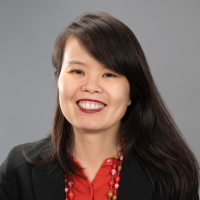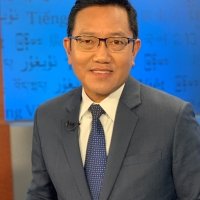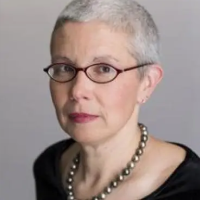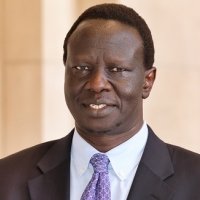Book Talk | Far From the Rooftop of the World: Travels Among Tibetan Refugees on Four Continents
Submit a question
By Estelle Erwich and Isabelle Steiner
Event Summary
As part of its mission to amplify lived experiences of refugees and increase visibility of issues impacting displaced people beyond the headlines, the Wilson Center’s Refugee and Forced Displacement Initiative (RAFDI) hosted Amy Yee on October 25, 2023, to discuss her book and experiences while writing it. Moderated by John Thon Majok, Director of RAFDI, the panel also included Kalden Lodoe, Tibetan Service Director at Radio Free Asia, and Sophie Richardson, an expert on human rights issues in China. The author discussed the experiences of forcibly displaced Tibetans she met, and the two discussants provided commentaries about the human rights abuses and conflict which led to this forced exodus, as well as the implications of the Tibetan issue for US foreign policy.
When Amy Yee rushed into a packed press conference with the Dalai Lama in Dharamsala, India, she could not find a place to sit. A seasoned international reporter with a deadline to meet, Yee simply took a seat on the floor. She expected her assignment to remain focused on the repression of Tibetan protestors by the Chinese government, occurring a nation away. However, a personal encounter with the His Holiness at this press conference in the center of the exiled Tibetan community in India put her on a new path: living amongst and reporting on the lives of Tibetan refugees living in diaspora across the world. Spanning fourteen years and four continents, her experiences and relationships with exiled Tibetans culminated in her book Far from the Rooftop of the World: Travels Among Tibetan Refugees on Four Continents. Interwoven with an exploration of the conflict and oppression which have driven Tibetans from their homes, Yee tells the dynamic stories of the individuals she grew to know over more than a decade. In a personal and comprehensive narrative, she shows the human face of those maintaining identity and personhood in spite of conflict and exile.
Context: Dharamsala, 2008
Yee has reported from Bangladesh, ten countries in Africa, and spent seven years writing in India. While on assignment in New Delhi in 2008, Yee was asked to cover a press conference being held in Dharmsala, the heart of the Tibetan exile community in India. At the time, the largest civil unrest in China since Tiananmen Square had broken out as Tibetans commemorated their original uprising against Chinese rule and faced intense suppression in response. At the subsequent press conference held by the Dalai Lama, Yee had a personal conversation with His Holiness in which he firmly encouraged her to tell the Tibetan story. That was the beginning of her eight-year journey of documenting the Tibetan diaspora.
What is in a Name? Far from the Rooftop of the World
Majok asked Yee to contextualize the title she chose for her book. She explained that due to its high altitude, Tibet is often referred to as the “rooftop of the world.” In writing the book, Yee traced the diaspora to completely different environments in places far away as Australia, where the Tibetan people had begun re-establishing their lives. She became fascinated with how while even thousands of miles away of the lofty “rooftops,” Tibetans still preserved their identities in exile. As an American who is ethnically Chinese, Yee explained her interest in how individuals can “move between worlds” while balancing different parts of their multifaceted identities.
Preserving Tibetan Cultural Identity
Yee spoke about the many Tibetans who had been born in India but still maintained a strong connection to their ethnic and religious identity. In response to a question from Majok about how this culture is maintained, she explained that the strong education system for Tibetans in India is essential. While following the same curriculum as all other schools in India, there are estimated 80 schools which are taught in the Tibetan language and incorporate other aspects of Tibetan culture, allowing students to maintain their native identity. In places like Australia, there are weekend schools for Tibetan youth which focus on language learning, art, dance, and other cultural and religious practices. Yee explained that when the Dalai Lama and the community at large began to establish themselves in India, their priority was establishing education systems which would preserve Tibetan identity despite exile. This focus has led to a diasporic community which is firmly rooted in its goals of preserving Tibetan identity and culture, regardless of location. When Tibetans first arrive, Yee said, they often have an audience with the Dalai Lama in which he is “exhorting them to study... [as] he sees this to be the key to the future.”
Human Stories and Dignities
Set in the broader context of this diaspora, Yee’s book focuses on several individuals whom she was able to meet over the years. They include Dhopden, a monk and avid basketball fan; Norbu, a chef who had been beaten, imprisoned, and blacklisted for being a bystander at a protest in his youth; and Deckyi and Dhondup, a couple who fled their accomplished corporate jobs in fear of retribution after they had photocopied fliers promoting human rights. The relationship which Yee established with these individuals over many years allows her writing to provide a close-up understanding of why people flee conflict and violence, and who these people are. She recounted Dhondup and Deckyi’s story, who were in such fear of retaliation for their simple actions that they fled their home instantaneously, with no goodbyes to any friends or family. Majok remarked on how important it is to share these experiences, as the average person only sees displaced people once they crossed international borders, often without considering the circumstances which pushed them to flee there.
Despite the tense political relationship and violent history between China and the Tibetan people, Yee remarked that she never felt like her own Chinese identity prevented her from being welcomed by the Tibetan people. She recounted one individual who assumed that Tibetans would be hostile towards her, but her experience was marked by the warmth of the Tibetan people and the relationships she established with them. She noted that the noticeable ability of the Tibetan people to “distinguish between a government and ordinary people is really remarkable.” In one such interview with a former political prisoner, she asked if he disliked the Chinese because of his experiences. The interviewee simply replied “no," as he had made many Chinese friends while in prison.
By uplifting human stories over simplified political narratives, Yee’s writing preserves individual experience from being overwhelmed by their backdrop of a decades-long international political conflict. Individuals can be individuals, rather than be lumped in with their government or citizenship status. Majok pointed to one review of Yee’s book from Peter Hessler of the New Yorker, who wrote that the individuals in the narrative are “never lost in the shadow of Chinese politics,” as Yee tells their stories in a way that captures the “details, dramas, and dignities of Tibetan life in exile.” Majok emphasized that this is the importance of Yee’s work – it humanizes those who are otherwise reduced to nameless numbers and labels, who may seem far away and defined by a few headlines in the news. Instead, Yee’s book provides full-bodied and holistic representations of people reestablishing themselves and maintaining their cultural identity even after facing violence, oppression, and exile.
Lived Experiences and Expert Perspectives
As a former monk and Tibetan refugee, Lodoe added the perspective of his lived experience, emphasizing that the book conveys a message of the mental resilience of individuals in the face of intense persecution. Richardson, who spent eleven years as the China Director at Human Rights Watch, contextualized the “pathologies of the human rights abuses,” which have taken place across China and Tibet, including arbitrary imprisonment, unfair judicial proceedings, and violent retaliation to public protest. Richardson explained the complete deprivation of rights that the Tibetan people have experienced in their home country, which underscore many of the experiences that Yee describes in her book. While accurately documenting the circumstances which have driven Tibetans into diaspora, Richardson applauded Yee for prioritizing “not just the facts of people’s experiences, but their feelings, perceptions, and emotions,” with a sense of compassion.
Richardson then highlighted the work being done to erase the evidence of human rights violations in China, as well as the policies designed to eradicate the Tibetan identity. Lodoe remarked how he has often wondered why the Chinese government have maintained a focus on Tibet, instead of other minorities under their control. He argued that China wants to create a “perfect image” of Tibet because any disruption there can cause embarrassment for the government. Lodoe referenced the late 1980s and early 1990s during the “hopeful period” where Tibetans began to rebuild in Tibet. However, Chinese policies limited the ability of Tibetans to utilize education to preserve their language and culture, significantly impacting the ability of the Tibetan identity to survive from generation to generation. Yee noted that despite such policies, Tibetan culture and identity however has continued to flourish as it has been transplanted to other regions of the world, where it continues to thrive and evolve.
After 64 years, Lodoe posited, the institution remains, and the Dalai Lama has been steadfast in maintaining the middle way approach. The Chinese constitution guarantees the right for self-determination, but through the middle way approach there has not been a tangible solution. Richardson highlighted the strength of the Tibetans in exile in creating a democracy where Tibetans can vote from around the world. She mentioned that in such discussions of the political situation, it is important to take the time to separate people from their governments. Lodoe shared his own positive personal experiences with Chinese individuals in Tibet, and unpacked the fabricated distrust in Tibetan people and their ability to coexist with others that the Chinese government has played a role in creating.
A Silver Lining?
Following a question-and-answer portion of the event, Richardson concluded her thoughts by emphasizing that there is nothing more extraordinary than the fact that despite an oppressive regime telling different communities that they have nothing in common, those communities still unite over a common purpose and stand up for one another. Lodoe reemphasized the importance of Yee’s book in its documentation of the Tibetan people’s fight to keep their culture and identity alive. In closing, Yee summarized her efforts by explaining that the Tibetan individuals she has met motivate her to continue telling their stories, regardless of the challenges she may face in doing so.
Speakers



Moderator

Hosted By

Refugee and Forced Displacement Initiative
The Refugee and Forced Displacement Initiative (RAFDI) provides evidence-based analyses that translate research findings into practice and policy impact. Established in 2022 as a response to an ever-increasing number of people forcibly displaced from their homes by protracted conflicts and persecution, RAFDI aims to expand the space for new perspectives, constructive dialogue and sustainable solutions to inform policies that will improve the future for the displaced people. Read more
